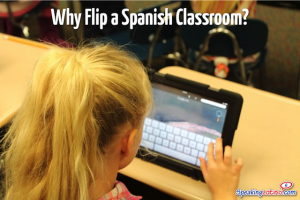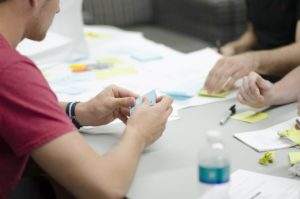
The Basics of Flipping
What is it?
A basic explanation of the Flipped classroom model is it is the reversal of when a student’s assigned tasks are completed. In a traditional classroom setup, the teacher lectures a class and assigns practice tasks for homework.
In the Flipped Classroom model, the lectures are assigned as preparation at home while the practice occurs in the classroom with peers and the instructor. The teacher, therefore becomes the facilitator in a student-centered classroom.
 Why flip a classroom?
Why flip a classroom?
In a traditional classroom setting, time is the enemy! The day-to-day occurrences in the school day and the interruptions from other students may put a dent in an already short 50-minute class period. If a teacher dedicates time to lecture, practice time is usually sacrificed.
On the other hand, those wanting to include more practice time may not have time in the classroom to teach concepts extensively enough. In a flipped classroom model, lessons are recorded and students may watch the lecture or lesson at their own pace, being able to pause, rewind or fast-forward the lesson at their convenience.
Students may now come to class prepared to ask questions or to practice the concepts that were introduced in the assigned lessons. Instant feedback in the application task is possible and the student works on developing competency on the skills.
The flipped model is technology based; therefore it taps into an environment where most students already feel comfortable. Not only are students comfortable in this environment, but as a society, we are growing more accustomed to learning by watching someone do something.
Goodbye to instruction manuals and hello to the YouTube generation! It just takes a question and a couple of key strokes on the YouTube search bar to find out that at least a dozen people had your same question and they’ve made a video about it. The users can interact with the authors, leaving feedback or even sparking a discussion topic. Intentionally or not, we have become a learning community.
Students who are absent have access to content while they are away, resulting in very little missed content.
There are many opinions of why flipping a classroom is a viable alternative. The Association for Supervision and Curriculum Development (ASCD) states that:
To date, there’s no scientific research base to indicate exactly how well flipped classrooms work. But some preliminary nonscientific data suggest that flipping the classroom may produce benefits. In one survey of 453 teachers who flipped their classrooms, 67 percent reported increased test scores, with particular benefits for students in advanced placement classes and students with special needs; 80 percent reported improved student attitudes; and 99 percent said they would flip their classrooms again next year (Flipped Learning Network, 2012). Clintondale High School in Michigan saw the failure rate of its 9th grade math students drop from 44 to 13 percent after adopting flipped classrooms (Finkel, 2012). [ … ] The lack of hard scientific evidence doesn’t mean teachers should not flip their classrooms; indeed, if we only implemented strategies supported by decades of research, we’d never try anything new. Until researchers are able to provide reliable data, perhaps the best we can do is to ask, Do the purported benefits of flipped classrooms reflect research-based principles of effective teaching and learning? Source: www.ascd.org
First Steps to Flipping a Spanish Classroom

Why Flip a Spanish Classroom (or any foreign language classroom)?
Even with the little research available, doing something innovative that may benefit the students and prepare them for the future educational models was very enticing to me. I love to teach languages! I love to teach languages because I loved learning languages. I was lucky to have a passion for languages, but also to have had the resources to learn in an almost immersion setting, and to have had constant comprehensible input from television, print and native speakers.
I figured that the only way that I could provide a similar experience to my students was to give them time to prepare at home and provide the opportunity to come to class to be exposed to the real deal. I don’t remember ever being captivated in my classes by a grammar lesson, but I do remember being engaged when I was able to understand and communicate in the language.
The more thought I put into the idea of flipping my class, the more I was convinced that it was going to be the right fit for most of my classes. Some of my motivations include:
1. Foreign language education in the United States is not a priority for many states and school districts. Even with all the research and breakthrough methods over the past few decades, many school programs consist on covering vocabulary and grammar concepts. Most of the newer textbooks have done a good job on pushing content within a familiar context, but at the end of the day, many schools and districts mandate examinations that focus on grammar and the mechanics of the language rather than communication. For even the most innovative teacher, teaching a grammar-centric class may be inevitable.
The Flipped Classroom model may allow teachers to cover grammar concepts, and free time to dedicate to authentic tasks in which those concepts can be applied in real world applications.
2. On the other hand, teachers who are fortunate enough to not be tied to traditional examinations or requirements, the flipped model allows for a more efficient use of time in the classroom. Students have to acquire vocabulary and communication patterns before they are able to develop competency, but the instructor becomes, as I mentioned before, a facilitator rather than a lecturer.
3. The Flipped Classroom model is attributed to teacher Jonathan Bergman and Aaron Sams from Woodland Park, Colorado. Their intention was mostly to help those students who were absent from class to keep up with their lessons. Besides trying to offer a more authentic experience, in my classroom, this was a practical reason why to try this model.
Spanish is a core course at the school where I teach, and often times, students are added to my courses at different times after the school year is in full swing. Some may come with some experience in Spanish, but many don’t. Having a flipped model could help new students catch up with the content taught prior to their enrollment in the course. These students may not have the same competency as the others do, but at least it provides some guidance so that the new students may be able to be incorporated as a contributing member of the class.
 How to flip a classroom?
How to flip a classroom?
In my experience, a successful flipped classroom requires a change in the culture of the learning community. We have spent many decades using the lecture model, especially starting in the middle school years. Students, parents and administrators will most likely resist this new model. Be patient and start small!
1. The most important task before you embark in this journey is to survey your students’ access to the Internet. Even if the students don’t have Internet access, it is possible to flip a classroom. Take inventory of the resources available to you. An example would be finding Internet access for some students at school during study hall and even after school hours. Even recording the videos and saving them to a DVD may help. If you are really committed to this model, you will find a way.
2. Select one unit of study and create the resources. It may also help to select only one of your classes on your first try.
3. Have clear objectives. Preparing summative tasks before you create your resources leads to a more successful outcome.
4. Train the students on the expectations.
5. Don’t just ask them to watch a video, assign a small task such as a graphic organizer to take notes or have them complete a task related to the assigned lesson as soon as they set foot in the classroom.
6. The students need to experience why you are trying this new model. You must be committed to having that amazing real world task for the students to complete. Nothing will kill your efforts quicker than having the students watch the video, complete a task and then sit through the same lesson they watched the night before. While you may be tempted to teach the lesson because you know that Suzy & Joe did not really watch the video, you are letting down all the other students. Make all students rise to your expectation.
7. Know that there will be setbacks. Your job as a teacher is to impart knowledge, so you may need to take a step back to your traditional methods if you find that what you are trying is not working for most students. This may seem to contradict my previous paragraph, but notice that I am talking about mass confusion amongst your students, rather than just a couple of students not rising to the expectations. If you find that your lessons are not being effective, show them to an experienced colleague for feedback. You may even show them to a friend or a spouse who may be able to put him or herself in the position of a learner and ask them to critique it.
 What technical knowledge do you need?
What technical knowledge do you need?
1. Flipping a classroom requires preparation and some basic knowledge of technology. This may seem intimidating or too time consuming, but consider that if you get over these hesitations and plan well, you can have lessons that may be current for multiple years.
2. Depending on how comfortable you are with the computer you may choose to record your own lessons or assign videos that have been made public by sites such as Khan Academy, YouTube or even other instructor’s public sites.
3. If you choose to record your own lessons, you can record yourself teaching in your classroom or create a presentation and record your screen.
4. To record yourself in the classroom, you may need a digital video camera. Depending on your camera, you may need software to convert your video to a format that may be uploaded to a website.
5. Keep in mind lighting in the classroom and the audio capabilities, you want the image to be clear so that the students can see your writing on the board and can hear your voice clearly.
6. If you choose to record your screen, you will need software such as QuickTime to do the actual recording and MS PowerPoint or KeyNote to prepare the presentations. You will also need a microphone so that the sound in clear. Depending on your teaching style, you may need hardware that allows you to write with a pen on your screen.
7. Whichever method you choose, please keep in mind that you are trying to engage the students.
8. Use vivid language. When you first start, it may be a good idea to write an outline or a script, but make sure that your intonation sounds natural.
9. Use themes and transitions that are not distracting to students.
10. Music may or may not be appropriate during the lesson.
11. As in every presentation, include an overview, develop the lesson and include a conclusion. It may be a good idea to include some examples or practice for the students to be able to monitor their learning immediately.
12. Make your videos available online on different platforms. Not all students are accessing the Internet on a personal computer, but are using their smart phones and tablets.
13. Make your videos short! A video that is longer than four minutes may not maintain the student’s attention. If the topic is too complex for a four minute video, consider breaking it down into one or more sub-topics.
Trying something new in your classroom will require changes in your teaching and will also require that you bring change to the existing culture of your learning community, but the outcomes will definitely help you and your students reflect on what works best in a classroom that wants to move forward.
This article about Flipping a Spanish Classroom is written by Analiza Torres, a Spanish and French teacher with 12 years of teaching experience. She also happens to be my sister-in-law and Diana’s sister! This article is from her personal experience flipping her Spanish classroom for the last two years. -Jared
Check out these articles for your Spanish Classroom.
